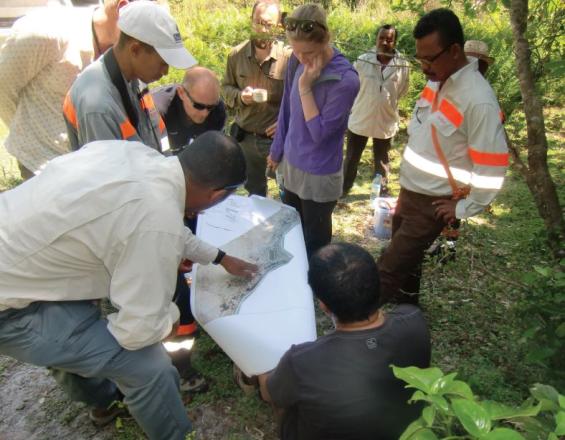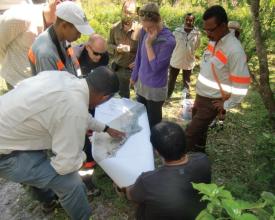
Nuevo protocolo para ayudar a la industria a generar un impacto positivo en la biodiversidad

Industrias como la minería, la silvicultura, el petróleo y el gas llevan años intentando minimizar su impacto ambiental y social, pero la sociedad civil, los organismos reguladores y los inversores esperan cada vez más que las empresas no sólo "no hagan daño", sino que contribuyan positivamente al medio ambiente y a la sociedad.
En muchas empresas, los proyectos siguen procedimientos para evitar o minimizar los impactos sobre la biodiversidad y restaurarla o compensarlos cuando son inevitables. Este marco, conocido como jerarquía de mitigación, es cada vez más utilizado por empresas y gobiernos para mejorar la gestión ambiental y contribuir a un impacto positivo neto (IPN) o una ganancia neta de biodiversidad (GNB).
Tras un compromiso de IPN por parte de la empresa minera Rio Tinto, la UICN trabajó con la empresa para desarrollar y poner a prueba un protocolo de revisión que pudiera seguir sus avances hacia el logro del IPN a nivel operativo. Este protocolo se puso a prueba en las operaciones de Rio Tinto en Australia, Mongolia y Madagascar.
Contexto
Défis à relever
Un reto clave es mantener el protocolo de revisión lo suficientemente sencillo como para que las empresas puedan aplicarlo con facilidad y, al mismo tiempo, abarcar mediciones exhaustivas y adecuadas.
En algunos casos, puede faltar información sobre biodiversidad que sirva de referencia para la medición, pero esto no debería ser un obstáculo para avanzar, ya que pueden encontrarse métodos de evaluación alternativos. Las ONG deben colaborar con los gobiernos para desarrollar un enfoque más normalizado de la evaluación y gestión de la biodiversidad.
Los plazos de restauración son inciertos, los esfuerzos pueden depender de planes de biodiversidad más amplios y no siempre es posible, al menos a corto plazo, recrear hábitats naturales complejos, pero tampoco esto debe ser una excusa para la inercia.
Conseguir una ganancia neta de biodiversidad lleva tiempo y requiere una planificación y revisión continuas, sistemas de apoyo sólidos y recursos suficientes.
Ubicación
Procesar
Resumen del proceso
En conjunto, estos elementos básicos demuestran que el desarrollo y mantenimiento de un programa eficaz de IPSN exige la colaboración y consulta entre diversos agentes. Esto exige una excelente facilitación y un entorno propicio por parte del gobierno y los organismos reguladores para la planificación integrada de la conservación.
Es necesaria una participación equilibrada de las partes interesadas internas y externas, junto con la comunidad científica, para ayudar a garantizar que el enfoque desarrollado sea pragmático.
Las ONG tienen un importante papel que desempeñar en la creación de condiciones equitativas. Si la buena gestión de la biodiversidad sigue siendo sobre todo una práctica voluntaria de unas pocas empresas, la biodiversidad seguirá perdiéndose cuando los lugares abandonados por estas empresas pasen a manos de las que no tienen normas ni políticas de gestión de la biodiversidad.
Bloques de construcción
Compromiso y recursos de la empresa
Los esfuerzos para obtener ganancias netas en biodiversidad suelen contar con un defensor. Puede tratarse del director ejecutivo de una empresa comprometido con la aplicación de este enfoque. Pero si esa persona se marcha, ese compromiso puede perderse o ser sustituido por otras prioridades. Por tanto, el beneficio neto de la biodiversidad debe integrarse en la mentalidad de la empresa a todos los niveles. La aplicación, la comunicación y la dotación de recursos son fundamentales y deben enmarcarse en los sistemas de gestión, presupuestación e información existentes. Es necesario un enfoque integrado de la gestión de riesgos, lo que significa que los equipos medioambientales, comunitarios y sociales deben trabajar con el personal de la empresa para compartir conocimientos y experiencias que ayuden a desarrollar planes de acción holísticos y resistentes.
Factores facilitadores
Proporcionar financiación, personal y orientación adecuados es fundamental para las iniciativas de ganancia neta de biodiversidad. Es importante desarrollar herramientas de fácil aplicación que integren este enfoque en el registro corporativo y la planificación a largo plazo.
Cuando forman parte de un requisito reglamentario o de un prestamista, las iniciativas son más sostenibles, sobre todo cuando se integran en planes más amplios y los acuerdos se negocian con las comunidades locales y las autoridades reguladoras. Los reglamentos y las condiciones de los prestamistas suelen ser fuertes motivadores para mantener el enfoque BNG.
Lección aprendida
Crear confianza y desarrollar relaciones entre la empresa, las ONG, el gobierno y las comunidades lleva tiempo, pero es fundamental para el éxito.
Hay que demostrar claramente que la ganancia neta de biodiversidad es rentable, ya sea por la demanda pública, la normativa o las expectativas de las partes interesadas. Un argumento empresarial sólido contribuirá a afianzar el compromiso a largo plazo con el coste de aplicación de una iniciativa.
Experimentar nuevos enfoques
Los nuevos enfoques de ganancia neta de biodiversidad deben ponerse a prueba y comunicar las lecciones aprendidas antes de extenderlos a otras unidades de la empresa o de promocionarlos públicamente. El establecimiento de una comunidad de prácticas para compartir lecciones y abordar retos comunes en toda la empresa o el sector debería facilitar una aplicación más amplia.
Probar el enfoque en varios sitios permite abordar los posibles retos y adaptar el enfoque en una fase temprana del desarrollo del programa. Una vez puesto en marcha el proyecto, deben realizarse "controles de salud" periódicos en los centros para comprobar los avances y mantener el impulso.
Factores facilitadores
Aunque no es deseable que un programa dependa de un único defensor para tener éxito, puede ser necesario identificar a una persona o grupo que pueda persuadir a su empresa de seguir el curso del BNG y proporcionar el estímulo hasta que el enfoque esté más firmemente arraigado.
Lección aprendida
Permitir la adaptación a circunstancias especiales: Deben tenerse debidamente en cuenta los retos locales, sobre todo teniendo en cuenta las grandes diferencias entre los entornos naturales, sociales y políticos en los que operan las empresas.
Implicar a las comunidades de acogida
Las comunidades deben participar en la planificación y ejecución cuando las actividades de impacto positivo neto puedan afectar a su vida cotidiana o a sus medios de subsistencia. Los aspectos relacionados con la tenencia de la tierra deben abordarse desde el principio, satisfaciendo las expectativas de las distintas partes interesadas y garantizando la sostenibilidad a largo plazo.
El plan de gestión de la biodiversidad de una empresa debe tener en cuenta las necesidades y aspiraciones de la comunidad y del paisaje en general, así como las prioridades de conservación nacionales y regionales.
Factores facilitadores
Una estrategia de comunicación y compromiso ayudará a garantizar que todos los usuarios de las tierras, los propietarios y las autoridades gubernamentales comprendan el plan de gestión de la biodiversidad y tengan la oportunidad de expresar sus preocupaciones y contribuir a su desarrollo.
Lección aprendida
Los enfoques deben desarrollarse en colaboración, incluyendo las aportaciones de las comunidades y los equipos de planificación y operaciones, para garantizar que los planes sean prácticos y cuenten con los recursos adecuados. Las ONG deben comprender plenamente el entorno operativo de una empresa para identificar las estrategias que tengan más posibilidades de éxito.
Impactos
Dado que el desarrollo continuo de infraestructuras y la extracción de recursos son inevitables para apoyar el crecimiento económico, los objetivos de ganancia neta de biodiversidad y las salvaguardias son importantes para garantizar que el desarrollo sea sostenible. Un número cada vez mayor de gobiernos, empresas y organizaciones están adoptando políticas y compromisos del tipo del IPB, y los prestamistas internacionales están incluyendo salvaguardias del IPB como parte de sus condiciones. El Protocolo de evaluación de la UICN para la ganancia neta de biodiversidad contribuye a un conjunto creciente de herramientas que pueden ayudar a empresas y gobiernos a salvaguardar la naturaleza.
La UICN está recurriendo a su red de gobiernos y ONG miembros para promover el uso de un enfoque de BNG proporcionando apoyo técnico, nuevos productos del conocimiento y herramientas, y una plataforma para compartir las lecciones aprendidas. El objetivo es ayudar a las empresas a lograr un beneficio neto para la naturaleza en sus operaciones y a nivel de paisaje.
Los conocimientos y la experiencia adquiridos en el desarrollo del protocolo contribuyeron a la estrategia global de Rio Tinto sobre biodiversidad y la empresa está ayudando a otros a integrar la biodiversidad en la gestión de riesgos y la gestión in situ. La UICN está ayudando ahora a otras empresas a poner en marcha el protocolo, entre ellas Newmont Mining y Black Mountain Mining.
El protocolo de evaluación está siendo utilizado por varias otras empresas en todo el mundo, y el número de empresas y gobiernos que se comprometen con un enfoque de IPN sigue creciendo.
Beneficiarios
El protocolo de revisión proporciona un marco para evaluar los avances, compartir experiencias y lecciones en una empresa o sector, cumplir las exigencias de prestamistas y reguladores y las expectativas de las partes interesadas. También puede ayudar a los centros a resolver los problemas de aplicación.
Objetivos de Desarrollo Sostenible
Historia
La estrategia de impacto positivo neto de Rio Tinto fue lanzada en el Congreso Mundial de Conservación de la UICN de 2004 y reiterada por el director general de la empresa en varios foros, incluido el Congreso de la UICN de 2008.
En ese momento, las declaraciones de posición y los principios rectores de la empresa en materia de biodiversidad reconocían que la conservación y la gestión responsable de la biodiversidad son importantes cuestiones empresariales y sociales. Rio Tinto reconoció que no contaba con suficientes conocimientos internos para poner en práctica un compromiso de IPN, por lo que recurrió a la ayuda de varias ONG, consultores y organismos de investigación para avanzar en el proceso, incluida una serie de ensayos.
El más exhaustivo de ellos se llevó a cabo en el emplazamiento del proyecto de Rio Tinto, QIT Madagascar Minerals (QMM), donde la empresa trabajó con especialistas en biodiversidad, entre ellos: Flora and Fauna International (FFI); Birdlife International con sus socios locales como Asity; The Biodiversity Consultancy (TBC); Missouri Botanical Gardens; Kew Gardens; Hardner and Gullison Associates; y una serie de académicos y otras consultorías, así como la UICN.
Esta colaboración dio lugar en 2010 a una nota de orientación interna de la empresa, que incluía una visión general de los conceptos y métodos como hoja de ruta para lograr la IPN y que desde entonces ha sido objeto de varias revisiones.
Además del ensayo QMM, la UICN ayudó con otros en Oyu Tolgoi en Mongolia y Dampier Salt en Australia. Mientras tanto, varios otros sitios, inspirados por el lanzamiento inicial del enfoque de la IPN, también empezaron a trabajar para lograrlo, explorando cómo incorporarlo a los planes de gestión del uso de la tierra y a las operaciones del sitio.
Explorar cómo un enfoque de IPN para la biodiversidad puede permitir al sector privado gestionar mejor la biodiversidad y contribuir a la conservación mundial fue el objetivo de la Alianza IPN, que incluyó a la UICN, Rio Tinto, Shell y The Nature Conservancy. La Alianza publicó dos documentos sobre el caso de negocio y el caso de conservación para la IPN en 2016.
El protocolo de revisión está siendo utilizado ahora por varias otras empresas, y el interés de los gobiernos en la IPN también está creciendo.
